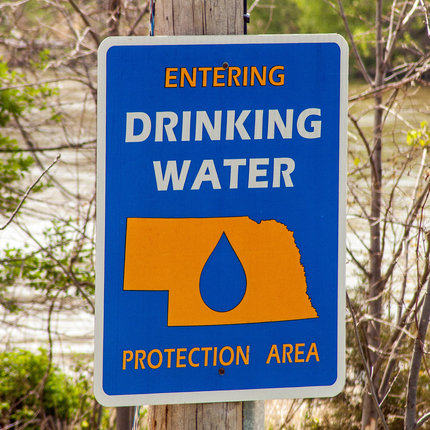By Johnathan Hladik, former policy director
Nitrates in drinking water can be hazardous to the health of pregnant women, nursing mothers, infant children, and the elderly. Methemoglobinemia, or “blue baby” disease, is a significant concern. Nitrates can also lead to uranium contamination, causing kidney damage and elevated blood pressure.
Nitrate pollution takes place when excess nitrogen enters the water supply. Overuse of chemical fertilizers on lawns and cropland as well as poorly managed animal waste from livestock facilities are primary sources. Nitrate pollution can occur anytime rainfall, snow melt, or excess irrigation flows over land and the water picks up pollutants and deposits them into streams, lakes, and rivers.
In March of this year Des Moines Water Works filed a lawsuit against three counties in northwest Iowa. The suit claims drainage districts in Buena Vista, Sac, and Calhoun counties are polluting the Raccoon River, an important source of drinking water for 500,000 residents in the City of Des Moines. In order to meet safe drinking water standards, Des Moines may be forced to spend between $76 million and $183.5 million to construct a new water treatment facility.
The cause of that pollution? Nitrate contamination, caused by agricultural activities. Each of the three counties included in the lawsuit has a documented history of high nitrate levels in rivers and streams.
Buena Vista, Sac, and Calhoun counties are predominantly agricultural. According to the United States Department of Agriculture, the three combined are home to 960,000 cattle, 1.2 million hogs, and just over 1 million turkeys. Tens of thousands of acres of cropland are in production each year. Directly or indirectly, farming is an important source of income for the majority of area residents.
Things aren’t so different here in Nebraska.
According to the Environmental Protection Agency's Toxics Release Inventory, Nebraska's waterways are the sixth worst in the nation for toxic pollution. Almost half of the rivers and streams monitored by the Department of Environmental Quality are too polluted to meet water quality standards. This affects groundwater, too. Studies have shown that the High Plains aquifer contains nitrate concentrations up to 189 times greater than standards set by state and federal water quality agencies.
The news isn’t all bad, however. To our knowledge, no Nebraska municipality is facing cost and equipment challenges as severe as those being experienced in Des Moines. For that, you can thank area farmers who pride themselves in being good stewards of the land.
Farmers throughout Nebraska are taking simple, common-sense steps to limit nitrate pollution. Some plant cover crops to absorb excess nitrogen. Others plant buffer strips that help prevent pollution from entering waterways. Still more create smart management plans to reduce runoff and limit chemical and fertilizer application.
This is crucial, because many communities cannot afford to invest in new and expensive water treatment equipment. Small towns serve fewer customers, which means every individual must cover a larger share of the cost. Many small towns are working diligently to attract new families and new businesses, and know that a high cost of living can cause potential neighbors to move elsewhere.
We all depend on water. That means we all have a responsibility to keep it clean. If there is one thing we have learned from Iowa, it’s that water quality isn’t cheap.
-----
This project is a partnership between the Center for Rural Affairs and the Federal Nonpoint Source Management Program.





